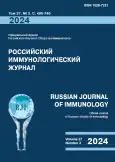Особенности экспрессии ингибиторных рецепторов PD-1 и TIGIT на CD4+ и CD8+Т-лимфоцитах различной степени зрелости
- Авторы: Власова В.В.1, Сайдакова Е.В.1
-
Учреждения:
- Институт экологии и генетики микроорганизмов Уральского отделения Российской академии наук – филиал ФГБУН «Пермский федеральный исследовательский центр Уральского отделения Российской академии наук»
- Выпуск: Том 27, № 3 (2024)
- Страницы: 553-558
- Раздел: КРАТКИЕ СООБЩЕНИЯ
- URL: https://journal-vniispk.ru/1028-7221/article/view/267523
- DOI: https://doi.org/10.46235/1028-7221-16619-TEP
- ID: 267523
Цитировать
Полный текст
Аннотация
Т-лимфоциты являются сложной и гетерогенной популяцией клеток, играющей центральную роль в адаптивном иммунном ответе. Среди Т-клеток выделяют две крупные популяции – CD4+Т-хелперы и CD8+ цитотоксические Т-лимфоциты, каждая из которых состоит из клеток разной функциональной направленности и степени зрелости. Известно, что активность Т-лимфоцитов строго регулируется различными ингибиторными рецепторами, в том числе PD-1 и TIGIT. Как правило, действие этих супрессорных молекул направлено на поддержание гомеостаза. Однако экспрессию ингибиторных рецепторов на Т-клетках также связывают с феноменом истощения. Особенности экспрессии данных супрессорных молекул на CD4+ и CD8+Т-лимфоцитах разной степени зрелости остаются малоизученными. Целью данного исследования было оценить экспрессию ингибиторных рецепторов PD-1 и TIGIT на различных субпопуляциях CD4+ и CD8+Т-лимфоцитов здоровых людей. Исследование включало 10 относительно здоровых добровольцев со средним возрастом 43 года. Идентификацию субпопуляций Т-лимфоцитов проводили методом проточной цитофлуориметрии. Среди CD4+ и CD8+Т-клеток выделяли наивные лимфоциты (CD45R0-CCR7+), клетки центральной (CD45R0+CCR7+) и эффекторной (CD45R0+CCR7-) памяти или терминально-дифференцированные эффекторы (CD45R0-CCR7-), на поверхности которых оценивали экспрессию ингибиторных рецепторов PD-1 и TIGIT. Было установлено, что экспрессия супрессорных молекул PD-1 и TIGIT на Т-лимфоцитах здоровых людей в значительной степени определяется стадией их дифференцировки. Так, в пуле наивных CD4+ и CD8+Т-лимфоцитов содержание клеток, несущих рецепторы PD-1 и TIGIT было существенно меньше, чем в более зрелых субпопуляциях (p < 0,05). Принадлежность к CD4+ или CD8+Т-клеткам также существенно влияла на характер экспрессии ингибиторных рецепторов. Установлено, что CD8+Т-лимфоциты отличаются от CD4+Т-клеток значительно большей долей TIGIT-позитивных элементов (p < 0,01). Важно отметить, что ингибиторный рецептор TIGIT присутствовал на подавляющем большинстве CD8+Т-лимфоцитов памяти и терминально-дифференцированных эффекторов, что не соответствует профилю экспрессии PD-1. Полученные результаты расширяют представление об особенностях экспрессии ингибиторных рецепторов на Т-клетках и подчеркивают необходимость пересмотра подходов к интерпретации данных в контексте функционального истощения.
Полный текст
Открыть статью на сайте журналаОб авторах
В. В. Власова
Институт экологии и генетики микроорганизмов Уральского отделения Российской академии наук – филиал ФГБУН «Пермский федеральный исследовательский центр Уральского отделения Российской академии наук»
Автор, ответственный за переписку.
Email: violetbaudelaire73@gmail.com
младший научный сотрудник лаборатории молекулярной иммунологии
Россия, ПермьЕ. В. Сайдакова
Институт экологии и генетики микроорганизмов Уральского отделения Российской академии наук – филиал ФГБУН «Пермский федеральный исследовательский центр Уральского отделения Российской академии наук»
Email: violetbaudelaire73@gmail.com
д.б.н., заведующая лабораторией молекулярной иммунологии
Россия, ПермьСписок литературы
- Blazkova J., Huiting E.D., Boddapati A.K., Shi V., Whitehead E.J., Justement J.S., Correlation between TIGIT expression on CD8+ T cells and higher cytotoxic capacity. J. Infect. Dis., 2021, Vol. 224, no. 9, pp. 1599-1604.
- Callender L.A., Carroll E.C., Bober E.A., Akbar A.N., Solito E., Henson S.M. Mitochondrial mass governs the extent of human T cell senescence. Aging Cell, 2020, Vol. 19, no. 2, e13067. doi: 10.1111/acel.13067.
- Ge Z., Peppelenbosch M.P., Sprengers D., Kwekkeboom J. TIGIT, the next step towards successful combination immune checkpoint therapy in cancer. Front. Immunol., 2021, Vol. 12, 699895. doi: 0.3389/fimmu.2021.699895
- Jia B., Zhao C., Rakszawski K.L., Claxton D.F., Ehmann W.C., Rybka W.B., Mineishi S., Wang M., Shike H., Bayerl M.G., Sivik J.M., Schell T.D., Drabick J.J., Hohl R.J., Zheng H. Eomes+T-betlow CD8+ T cells are functionally impaired and are associated with poor clinical outcome in patients with acute myeloid leukemia. Cancer Res., 2019, Vol. 79, no. 7, pp. 1635-1645.
- Jubel J.M., Barbati Z.R., Burger C., Wirtz D.C., Schildberg F.A. The Role of PD-1 in acute and chronic infection. Front. Immunol., 2020, Vol. 11, 487. doi: 10.3389/fimmu.2020.00487.
- Knox J.J., Cosma G.L., Betts M.R., McLane L.M. Characterization of T-bet and eomes in peripheral human immune cells. Front. Immunol., 2014, Vol. 5, 217. doi: 10.3389/fimmu.2014.00217.
- Koch S., Larbi A., Derhovanessian E., Ozcelik D., Naumova E., Pawelec G. Multiparameter flow cytometric analysis of CD4 and CD8 T cell subsets in young and old people. Immun. Ageing, 2008, Vol. 5, 6. doi: 10.1186/1742-4933-5-6.
- Lanzavecchia A., Sallusto F. Dynamics of T lymphocyte responses: intermediates, effectors, and memory cells. Science, 2000, Vol. 290, no. 5489, pp. 92-97.
- Li G., Yang Q., Zhu Y., Wang H.R., Chen X., Zhang X., T-Bet and eomes regulate the balance between the effector/central memory T cells versus memory stem like T cells. PLoS One, 2013, Vol. 8, no. 6, e67401. doi: 10.1371/journal.pone.0067401.
- Long E.O. Regulation of immune responses through inhibitory receptors. Annu. Rev. Immunol., 1999, Vol. 17, pp. 875-904.
- Odorizzi P.M., Wherry E.J. Inhibitory receptors on lymphocytes: insights from infections. J. Immunol., 2012. Vol. 188, no. 7, pp. 2957-2965.
- Rumpret M., Drylewicz J., Ackermans L.J.E., Borghans J.A.M., Medzhitov R., Meyaard L. Functional categories of immune inhibitory receptors. Nat. Rev. Immunol., 2020, Vol. 20, no. 12, pp. 771-780.
- Tian Y., Babor M., Lane J., Schulten V., Patil V.S., Seumois G., Unique phenotypes and clonal expansions of human CD4 effector memory T cells re-expressing CD45RA. Nat. Commun., 2017, Vol. 8, no. 1, 1473. doi: 10.1038/s41467-017-01728-5.
- Wherry E.J., Kurachi M. Molecular and cellular insights into T cell exhaustion. Nat. Rev. Immunol., 2015, Vol. 15, no. 8, pp. 486-499.
- Zhao J., Li L., Yin H., Feng X., Lu Q. TIGIT: An emerging immune checkpoint target for immunotherapy in autoimmune disease and cancer. Int. Immunopharmacol., 2023, Vol. 120, 110358. doi: 10.1016/j.intimp.2023.110358.
Дополнительные файлы









